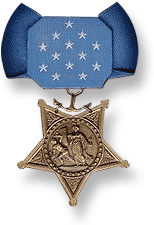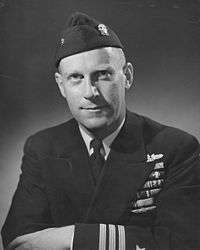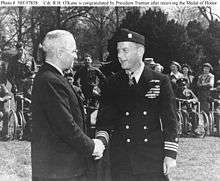Richard O'Kane
| Richard Hetherington O'Kane | |
|---|---|
  Commander Richard H. O'Kane, USN | |
| Born |
February 2, 1911 Dover, New Hampshire |
| Died |
February 16, 1994 (aged 83) Petaluma, California |
| Place of burial | Arlington National Cemetery Arlington, Virginia |
| Allegiance |
|
| Service/branch |
|
| Years of service | 1934-1957 |
| Rank | Rear Admiral |
| Commands held | USS Tang |
| Battles/wars | World War II |
| Awards |
Medal of Honor Navy Cross (3) Silver Star (3) Legion of Merit Purple Heart Presidential Unit Citation (2) |

Rear Admiral Richard Hetherington “Dick” O'Kane (February 2, 1911 – February 16, 1994) was a United States Navy submarine commander in World War II, who received a Medal of Honor for his service on the Tang. He also served on the Wahoo, as executive officer and approach officer. He participated in more successful attacks on Japanese shipping than any other submarine officer during the war.
Biography
O'Kane was born in Dover, New Hampshire. He was the youngest of four children of University of New Hampshire entomology professor Walter Collins O'Kane, of Irish ancestry, and his wife, Clifford Hetherington.[1] He graduated from Phillips Academy, Andover in 1930, and the U.S. Naval Academy in May 1934. He spent his first years of active duty on the heavy cruiser Chester and destroyer Pruitt. He received submarine instruction in 1938 and was then assigned to the USS Argonaut. O'Kane qualified for submarines aboard Argonaut in 1938 and remained aboard until her overhaul at Mare Island in 1942.[2]
In early 1942, Lieutenant O'Kane joined the precommissioning crew of the new submarine Wahoo and served as her Executive Officer (XO) on five war patrols, first under Lieutenant Commander Marvin G. "Pinky" Kennedy and later under the legendary Lieutenant Commander Dudley "Mush" Morton. Morton established a record as an excellent tactician, as he preferred to run the demanding analysis and plots while his XO manned the periscopes, a reversal of standard practices. Under Morton's tutelage, O'Kane developed the skills which enabled him to become the single most accomplished American submarine commander in history.[3][4]
In July 1943, Lieutenant Commander O'Kane was detached from Wahoo and soon became Prospective Commanding Officer (PCO) of Tang, which was then under construction. He placed her in commission in October 1943 and commanded her through her entire career. He was an innovator, and developed several operational tactics that markedly increased his ship's efficiency. Among these tactics were daylight surface cruising with extra lookouts, periscope recognition and range drills (enabling clear tactical sureness when seconds counted), and methods of night surface attacks, one of his favorite techniques to obtain and maintain the initiative in battle.
In five war patrols, O'Kane sank an officially recognized total of 24 Japanese ships – the second highest total for a single American submarine and the highest for a single commanding officer. This total was revised in 1980 from a review of Japanese war records corroborated by Tang's surviving logs and crewmembers to 31 ships totalling over 227,000 long tons (231,000 t) sunk. These numbers were among the highest in the Pacific War for submarines.[5] Several times during the war he took the Tang into the middle of a convoy and attacked ships ahead and behind—counting on Tang's relative position, speed, and low profile to keep clear of enemy escorts. Under O'Kane, Tang also performed "lifeguard duty", a common joint operation, with a Fast Carrier Task Force, of positioning one or more submarines in a "ditching station" off an enemy island under air attack in order to rescue downed pilots. Off Truk, he and the Tang rescued 22 airmen in one mission, thus earning a Presidential Unit Citation.
Tang's third patrol, into the Yellow Sea, sank more Japanese ships than any other submarine patrol of the war. O'Kane claimed eight ships sunk; post-war analysis increased this to 10 ships. During one attack, he fired six torpedoes at two large ships. Japanese records showed the torpedoes actually hit four ships. This meant number of sinkings surpassed the next highest patrol, Wahoo's (with O'Kane as Executive Officer) in the same area the year before.
O'Kane was captured by the Japanese when Tang was sunk in the Formosa Strait by her own flawed torpedo (a circular run of a Mark 18) during a surface night attack on October 24–25, 1944. O'Kane lost all but eight members of his crew, and was at first secretly held captive at the Ōfuna navy detention center, then later moved to the regular army Omori POW camp.[6] Following his release, O'Kane received the Medal of Honor for "conspicuous gallantry and intrepidity" during his submarine's final operations against Japanese shipping.

In the years following World War II, O'Kane served with the Pacific Reserve Fleet as commanding officer of the submarine tender Pelias, testified at Japanese war crimes trials, was executive officer of the submarine tender Nereus and was Commander, Submarine Division 32 (ComSubDiv 32). He was a student at the Armed Forces Staff College in 1950–51 and was subsequently assigned to the Submarine School at New London, Connecticut, initially as an instructor and, in 1952–53, as the commanding officer.
Promoted to the rank of Captain in July 1953, O'Kane commanded the submarine tender Sperry until June 1954 and then became Commander, Submarine Squadron Seven (ComSubRon 7). Following studies at the Naval War College in 1955–56, he served in Washington, D.C., with the Ship Characteristics Board. O'Kane retired from active duty in July 1957 and, on the basis of his extensive combat record, was simultaneously advanced to the rank of Rear Admiral on the Retired List.[3]
O'Kane died in Petaluma, California at 83.[7] He is buried in Arlington National Cemetery, Section 59, Grave 874.[8] His wife was later buried beside him.
World War 2 summary
| Departing From | Date | Days | Wartime Credit Ships/Tonnage |
JANAC[9] Credit Ships/Tonnage |
Patrol Area | |
|---|---|---|---|---|---|---|
| Tang-1 | Pearl Harbor, TH | January 1944 | 41 | 5 / 42,000[10] | 5 / 21,429[11] | Marianas |
| Tang-2 | Pearl Harbor, TH | March 1944 | 61 | zero / zero[12] | zero / zero[11] | Palau |
| Tang-3 | Pearl Harbor, TH | June 1944 | 36 | 8 / 56,000[13] | 10 / 39,160[11] | East China Sea |
| Tang-4 | Pearl Harbor, TH | August 1944 | 34 | 5 / 22,500[14] | 2 / 11,463[11] | Empire |
| Tang-5 | Pearl Harbor, TH | September 1944 | lost | 13 / 107,324[15] | 7 / 21,772[11] | Formosa |
| Ranking | Number of Patrols | Ships/Tons Credited |
Ships/Tons JANAC |
|---|---|---|---|
| 1 | 5 | 31 / 227,824[16] | 24 / 93,824[11] |
Awards and decorations
In addition to the Medal of Honor, O'Kane received three Navy Crosses, three Silver Stars, the Legion of Merit with "V" device for valor, the Purple Heart and several other decorations. He wrote books about his service on Tang and Wahoo, entitled Clear the Bridge!: The War Patrols of the USS Tang and Wahoo: The Patrols of America's Most Famous World War II Submarine, respectively.
Admiral O'Kane was also awarded the American Defense Service Medal, Asiatic-Pacific Campaign Medal with nine battle stars, World War II Victory Medal and the National Defense Service Medal. He was also retroactively entitled to the Prisoner of War Medal and the Combat Action Ribbon.
| Medal of Honor | |
|
Navy Cross with two gold award stars |
|
Silver Star with two gold award stars |
|
Legion of Merit with Valor device |
|
Navy Commendation Medal with Valor device |
| Purple Heart | |
| Combat Action Ribbon | |
| Prisoner of War Medal | |
|
Navy Presidential Unit Citation (three awards) |
|
American Defense Service Medal with "Fleet" clasp |
|
Asiatic-Pacific Campaign Medal with nine battle stars |
| World War II Victory Medal | |
| National Defense Service Medal |
Legacy
In 1998, the Arleigh Burke-class destroyer USS O'Kane (DDG-77) was named in honor of O'Kane.
The wardroom of the oldest submarine in the United States fleet carries O'Kane's personal cribbage board, and upon decommissioning the board is transferred to the next oldest boat.[17][18]
Medal of Honor citation
Rank and organization: Commander, United States Navy, commanding U.S.S. Tang. Place and date: Vicinity Philippine Islands, October 23, and October 24, 1944. Entered service at: New Hampshire. Born: February 2, 1911, Dover, N.H.
Citation:
For conspicuous gallantry and intrepidity at the risk of his life above and beyond the call of duty as commanding officer of the U.S.S. Tang operating against 2 enemy Japanese convoys on 23 October and 24 October 1944, during her fifth and last war patrol. Boldly maneuvering on the surface into the midst of a heavily escorted convoy, CMDR O'Kane stood in the fusillade of bullets and shells from all directions to launch smashing hits on 3 tankers, coolly swung his ship to fire at a freighter and, in a split-second decision, shot out of the path of an onrushing transport, missing it by inches. Boxed in by blazing tankers, a freighter, transport, and several destroyers, he blasted 2 of the targets with his remaining torpedoes and, with pyrotechnics bursting on all sides, cleared the area. Twenty-four hours later, he again made contact with a heavily escorted convoy steaming to support the Leyte campaign with reinforcements and supplies and with crated planes piled high on each unit. In defiance of the enemy's relentless fire, he closed the concentration of ship and in quick succession sent 2 torpedoes each into the first and second transports and an adjacent tanker, finding his mark with each torpedo in a series of violent explosions at less than 1,000-yard range. With ships bearing down from all sides, he charged the enemy at high speed, exploding the tanker in a burst of flame, smashing the transport dead in the water, and blasting the destroyer with a mighty roar which rocked the Tang from stem to stern. Expending his last 2 torpedoes into the remnants of a once powerful convoy before his own ship went down, Comdr. O'Kane, aided by his gallant command, achieved an illustrious record of heroism in combat, enhancing the finest traditions of the U.S. Naval Service.
Works
- O'Kane, Richard H. (1977). Clear the Bridge!: The War Patrols of the USS Tang. Chicago: Rand McNally. ISBN 978-0-528-81058-9. OCLC 2965421.
- O'Kane, Richard H. (1987). Wahoo: The Patrols of America's Most Famous World War II Submarine. Novato, California: Presidio Press. ISBN 978-0-89141-301-1. OCLC 15366413.
See also
Notes
- ↑ Tuohy 2009, p. 125
- ↑ O'Kane, Richard H. WAHOO The Patrols of America's Most Famous WWII Submarine (1987) Presidio Press ISBN 0-89141-301-4 pp.1-3
- ↑ "USS Wahoo (238) of the US Navy". Retrieved October 9, 2010.
- ↑ "USS O'Kane's biography of Richard O'Kane". United States Navy. Archived from the original on May 27, 2009. Retrieved February 25, 2010.
- ↑ O'Kane, Richard H. Clear the Bridge! The War Patrols of the USS Tang London Macdonald & Jane's 1978 pp462-6 ISBN 0354011855
- ↑ "Richard O'Kane, 83, U.S. Submarine Hero". New York Times. February 23, 1994. p. A16.
- ↑ "Arlington National Cemetery Website". Richard Hetherington O'Kane: Rear Admiral, United States Navy. Arlington National Cemetery.net. August 10, 2006. Retrieved February 25, 2010.
- ↑ Joint Army-Navy Assessment Committee. Blair rounded entries in his tables (see Blair 1975, p. 900, bottom) while Roscoe's tables are an accurate transcription of the JANAC report.
- ↑ Blair 1975, p. 943
- 1 2 3 4 5 6 Roscoe 1949, p. 558
- ↑ Blair 1975, p. 944
- ↑ Blair 1975, p. 952
- ↑ Blair 1975, p. 955
- ↑ Blair 1975, p. 959
- ↑ Blair 1975, pp. 984–987
- ↑ "USS Los Angeles Embarks With a Piece of Submarine History". US Navy. May 16, 2007.
- ↑ "Pearl Harbor Bids Farewell to USS Los Angeles". US Navy. Jan 16, 2010.
References
- The Joint Army Navy Assessment Committee (3 February 1947). "Appendix: Japanese Shipping Lost by United States Submarines". Japanese Naval and Merchant Shipping Losses During World War II by All Causes. HyperWar Foundation. Retrieved 23 November 2011.
- Blair, Clay Jr. (1975). Silent Victory: The U.S. Submarine War Against Japan. Philadelphia and New York: J. B. Lippincott Company. ISBN 0-397-00753-1.
- Roscoe, Theodore (1949). United States Submarine Operations in World War II. Annapolis, Maryland: United States Naval Institute.
- Tuohy, William (2009). The Bravest Man. Random House. ISBN 0307554872.
Further reading
- "Richard H. O'Kane". Claim to Fame: Medal of Honor recipients. Find a Grave. Retrieved February 22, 2010.
- Escape from the Deep: A Legendary Submarine and Her Courageous Crew. Perseus Books Group. ISBN 0-306-81519-2. Retrieved February 25, 2010.
- "Rear Admiral Richard O'Kane". Fleet Submarine.com. Retrieved February 25, 2010.
- McDaniel, J. T. (2005). U.S.S. Tang (SS-306): American submarine war patrol reports. Riverdale Books. ISBN 1-932606-05-X. Retrieved February 25, 2010.
|